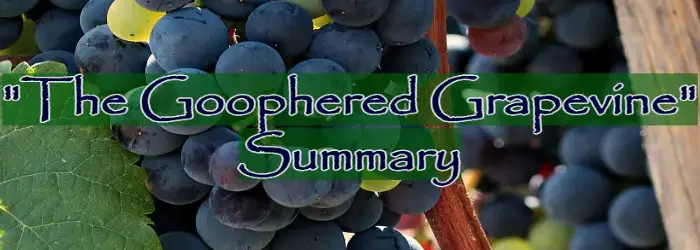
“The Goophered Grapevine” is a short story by Charles Waddell Chesnutt from his 1899 collection The Conjure Woman. It’s a story within a story about the history of a North Carolina vineyard that, supposedly, is cursed. Here’s a summary of “The Goophered Grapevine”.
“The Goophered Grapevine” Summary
John and Annie, Northerners, move to Patesville, North Carolina for Annie’s health. It’s also a suitable place for John to pursue the grape business, as he has experience with vineyards. His cousin, who lives there, assured him it was an ideal place.
On arriving, the weather is delightful and his cousin is a gracious host. John looks at the McAdoo plantation, which is long-neglected but looks like a promising site for a vineyard. He takes Annie to see it. The carriage ride is long and the road is sandy. Forgetting how to get there, they wait at a crossroads until a little Black girl comes by who tells them the way.
The grounds are decayed and the house is destroyed from the war. They walk the grounds then go sit on a pine log where a colored man eats grapes. John asks him about the vineyard. The man tells him he wouldn’t buy it; it’s goophered—cursed. He offers to tell them the vineyard’s story and they readily accept.
Dugal McAdoo was the plantation master before the war, and it produced a lot of wine. The Black people in the area, slaves and free alike, loved the grapes and used to take what they could. Dugal tried to keep them out but never succeeded in catching anyone.
He came up with a plan. He went to visit a conjure woman, Aunt Peggy, who was feared for her curses. He hired to goopher the grapevine. After carrying out her task, she told one of the people that any Black person who ate a grape from the vineyard would die within a year.
They leave his grapes alone from then on. One day, a visiting Black man eats some grapes. He’s killed that evening in an accident. Later, one of the kids eats some and dies the next week.
The next season, a field hand dies so Dugal buys another slave, Henry. His fellows forget to tell him about the curse because an escape attempt at a neighboring plantation has them distracted. He eats some grapes. They tell the overseer, who takes Henry to Aunt Peggy in the hope she can save him. She gives him some medicine that will hold him until spring.
In the spring, Henry takes her a ham in exchange for being able to eat all the grapes he wants. On top of that, the previously bald Henry grows the biggest head of hair on the plantation. It curls, resembling grapes. In the fall, his hair straightens and when the vines are bare he loses it again and his rheumatism gets bad.
“The Goophered Grapevine” Summary, Cont’d
The cycle repeats next season with his body loosening up in spring and worsening after the season, and his hair growing and falling out again. Next spring when Henry is at his peak, Dugal sells him for fifteen hundred dollars. When he deteriorates after the season, his new master calls the doctor but nothing helps.
One day in winter, Dugal meets up with Henry’s new master and casually asks about him. Hearing about the problems, he offers to buy Henry back for five hundred dollars as a favor. They soon make the deal. Dugal takes Henry back and provides what he needs to get through the winter until his resurgence in spring when he can sell him again. Dugal keeps this scheme going for about five years.
A Yankee visits the plantation, telling Dugal he could make it twice as productive. Dugal follows his instructions and has the slaves dig all around the vines and then pour in a mixture. The visitor also wins a lot of money playing cards with Dugal.
In spring, the plantation grows fast and thick, as does Henry’s hair. With all the work to do, Dugal decides to keep Henry on this year. The vines soon begin to die. There’s a cycle of slight improvement and then getting worse, mirrored by Henry’s condition and hair, with the vines and Henry eventually dying.
Dugal is furious. He has the slaves restore the vineyard, but it’s years before it produces again. When the war broke out, Dugal raised a company and eagerly set off to kill Yankees for his loss. He gets killed instead. After the war, the vineyard is abandoned.
With his story over, the man again advises John not to but the vineyard because it’s still goophered.
John did buy the vineyard and it’s been thriving a long time. He later learned that the man who told him the story, Uncle Julius, made a good living from the neglected vines, and suspects this motivated his advice not to buy it. John hired Uncle Julius as a coachman and believes his wages more than compensated him for his loss.
I hope this summary of “The Goophered Grapevine” by Charles Chesnutt was helpful.